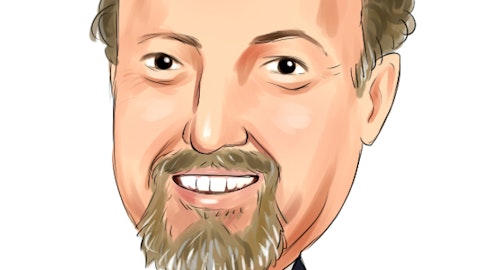And I think that we’ll see rig count increase only because it’s supplying the inventory of DUCs required to run a very smooth, stable-type business. And I would say our customers largely plan their business around turning wells into production more than they do numbers of rigs in the air. And so I think there’s a lot of planning that goes on to deliver a very stable business of completing wells. And so I think one of the reasons I would say I’d take the over on rig count, I don’t think — I won’t try to forecast rig count at this point. But I do think there’s upside in North America. We plan the business for what we can see, and we expect it to be stable. But that being said, I think there are obviously factors that could push that up. Like gas activity is clearly out there and I would pull the pace at which LNG plants come online, but we know that they will.
Is it ’24 event or a ’25? I think we’ll get to that point and see that Halliburton participates in that upside, and that could happen this year. But at this point, we’re planning the business around returns.
Luke Lemoine: Okay. And I guess a follow-up with this more stable North American business, you talk about your North American land margins you’re ascribing flat in 4Q. Could you talk about how you see this progressing in ’24 kind of with that stable business?
Jeffrey Miller: Well, look, let’s just leave it at steady and stable moving forward. I think that we’ve got a very strong international business as well that contributes, and I think that continues to grow and expand margins. But we’re really pleased with where we are. But U.S. revenue and margins flattish through any cycle, I think, is where we wanted to get this business. Clearly, there’s upside. And I do expect from a C&P standpoint, we’re going to see the benefit of our market leadership positions in PE, cementing, baroid and other things that we do around the world. So I think that we’re going to continue to participate in that meaningfully, particularly from a margin standpoint. But again, our key in North America is stability through cycles. And I think we’re demonstrating — I don’t think, I know we’re demonstrating that now.
Operator: Our next question comes from Stephen Gengaro with Stifel.
Stephen Gengaro: Two for me. Wanted just to follow up on the prior question around sort of margins in C&P and the Zeus fleets. When you talk about these assets being contracted, are there any difference in sort of the pricing dynamic versus sort of prior cycles and price openers quarterly? And how should we just think about the pricing for those assets in an environment where maybe there’s a little excess capacity near term from some, quite honestly, maybe not as competitive assets but older assets in the market? Does it matter — is pricing pretty stable? Can you talk about that a bit?
Jeffrey Miller: Look, these are long-term deals that we go into knowing the cost of the asset and knowing what the return needs to be. So now it just becomes a bit of a math problem around duration. And so there are variable costs in the market that we don’t control and we don’t try to own. We just pass through to customers, whether it’s sand cost and many other things. But for — where we create competitive advantage for our equipment is we go into these long-term vehicles. We don’t need price opener and all of that sort of jazz. There’s no reason for it. We literally sit down and work through what is the return for client, return for Halliburton, and then we fix that and move forward. That doesn’t change over time. And so — well, the rest of the market, the spot-type market, all of that is going to do what it’s going to do.
But I think that’s when we take a long view of the market in value creation, that’s math that both clients and how can do. And I think that’s what makes it so very different, our approach in North America. It’s not particularly differentiated, if at all, in the spot market. And as a result, it’s just kind of does what it does. It’s on a free for all. But I would say, in the market where we want to play, which is technology-driven, lowest total cost of ownership and working on, I think, most important, which is productivity per foot. That’s a different game. That’s a long-term game.
Stephen Gengaro: Great. And then just one quick one, probably for Eric, on the cash flow statement. Anything we should know about working capital parameters in ’24 versus ’23 that would be much different as we kind of build out the models, whether it’s DSOs or payables, et cetera?
Eric Carre: No. I think what’s important around free cash flow is, as I mentioned earlier, is we’re expecting the free cash flow to be at least 10% over ’23. That’s going to be on the back of improved income. It’s going to be on the back also of improved efficiencies around working capital. So we spend a lot of time working on improving DSOs, working on improving DIOs. And when I speak like this, I don’t mean just pushing the organization, I mean implementing different initiatives. For example, I’ll give you a couple of examples on DSO. We spend a lot of time on automating the invoicing process on integrated services. For example, invoicing on integrated service is extremely complicated. We have multiple product lines, multiple parts of our organization, customer organization, so it takes a lot of time.
And to the extent that you can automate that and then remove — reduce cycle time, then you improve DSO. We just rolled out 18 months ago a company-wide demand planning software, which when combined with the rollout of S/4 in the future is going to give us totally different capabilities to plan our business and reduce inventory while not increasing the risk from an operation perspective. So these are the things where we’re spending a lot of our time to basically structurally improve the efficiency of working capital. So that’s going to be the other component of why we’re expecting our free cash flow to improve next year.
Operator: Our next question comes from Marc Bianchi with TD Cowen.
Marc Bianchi: I just wanted to first clarify on the North America outlook that you provided for it to be flat. That’s a comment for the full year. Is that correct? Or was that a comment from where run rates are today?





